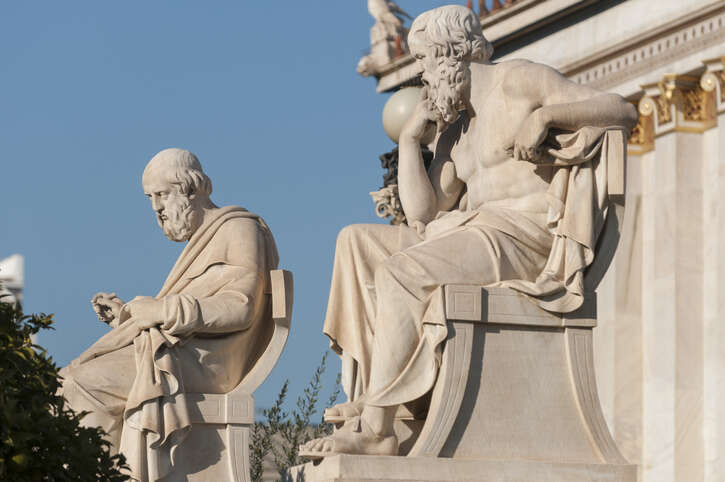
We made for the railway station, dipped through the tunnel under the rails, and then began climbing the path that separates Bessards from Le Méal. After a while, those heading for the Chapelle can turn left through a gate next to a tumbledown hut in the vines. From there, the track leads up to a viewpoint over Tain, whose array of substantial blocks, warehouses, and mansions looks Savoyard, their roofs tensed for snow-bearing. The Alps, you realize, can’t be far away. The river curled in front of us like a fat white python, making for the sun and the south, having slid silently around the great hill to our right. A train trickled into Tain. Mists thickened the light between us and the intermittent terraces of St-Joseph, across the valley.
We turned away from this balcony, and then skidded, slipped, and slid up to the Chapelle. There was no dedicated path anymore, and the granite fragments strewn at the edge of the vines proved treacherous underfoot. A comradely pull or two, and we’d made it: half an hour from hotel to Hermitage, and plenty of light to spare. We celebrated by strolling on to the very highest vineyards of all, at around 1,060ft (325m): Le Gros des Vignes. From here, the Chapelle slips into insignificance again, just a punctuation mark among others. It is the hill’s breadth you feel now.
In terms of landscape, this is a Gallic echo of the Rheingau. A great river moving along a north–south axis, in other words, suddenly jinks east–west; vine growers celebrate. That aberration creates a magnificent set of south-facing slopes that beg for terracing. It may be harder work than on the plain, but those first clearing the scrub, and shoring up the stone that lay beneath it, must have known that the wine they were to produce would reward hard labor. We’re far enough north, here, for ripening to be a struggle. On Hermitage, topography helps cheat latitude. The vines can bask.
The Rhône, its Isère tributary, and the little River Bouterne that now punctuates the base of the hill of Hermitage have done a lot of jinking, of rising and of falling, and of dropping and dumping in the past few million years. The sea has visited, and retreated; the ice has come and gone; violent winds have carried and shifted fine soil particles. The result of all this eventfulness is that the hill is now a long loaf of jumbled geological origin: granite spliced to limestone; pebbles, cobbles, clays, sands, and loess layering each other in counterintuitive series. Most of the vines through which we walked on our western, granite route to the top were Syrah; elsewhere on the hill, though, Marsanne has chief call on a tenancy.
Marsanne, man, and mountain
The first mention of Marsanne comes in 1781, in connection with the white wine of Hermitage. Back then, it would seem as if Roussanne was the principal white variety—though “plusieurs personnes y mêlent de la Marsanne, autre raisin blanc qui rend le vin un peu liquoreux” (“several people mix in Marsanne, another white grape that leaves the wine abitsweet”).1 That propensity to richness was remarked, and enjoyed… And now it’s Roussanne, not Marsanne, that is exceptional on Hermitage. Not only that, but the bold take their healthiest bunches of Marsanne on to a further, post-harvest stage of ripening—by drying the fruit for two more months or so, once on straw but now more generally in slatted wooden cases. And none bolder than the Cave de Tain, whose efforts with this style since 1985 have given Hermitage Vin de Paille a commercial identity that might otherwise have eluded it. (The Cave and its members own around 16 percent of Hermitage’s meager 136ha [336 acres] and make around 900 half-liter bottles of Vin de Paille in propitious vintages.)
Shortly before climbing the hill, I’d drunk the 2011 vintage of the Cave de Tain’s Vin de Paille—and been shocked by just how good it was. This wine was much more than the rare curiosity I was anticipating. It had the diagnostic aromatic complexity of fine wine. Apricots and butter, yes, of course—but I hadn’t expected the dried wild flowers, the splintered nougat, or the soapy jasmine. It came out of the glass in a thick slice, dripping with good things, like a Greek pastry. Buttered peaches more than apricots (an extra juiciness), with honey, sweet oranges, jasmine again, straw itself, white almonds, lemon verbena: a festival glass in starburst yellow. There was vitality alongside succulence. Could shy, sometimes clumsy Marsanne really perform like this? Or was it the magic mountain that made all the difference?
That was what I was thinking about while we made our quiet way down the hill. As Méal approached—where the Cave de Tain’s oldest Marsanne is located—a few last beams of low, golden sunlight came breaking, romping, and lamping through the gray mist, from the west, as if to say “yes.”
1 P Rézeau, Dictionnaire des Noms de Cépage de France (CNRS; Paris, 1997); quoted in J Robinson, J Harding, and J Vouillamoz, Wine Grapes (Allen Lane; London, 2012), p.600. / Illustration by Dan Murrell




